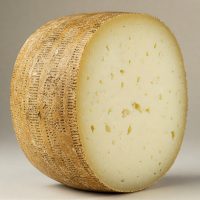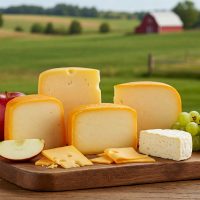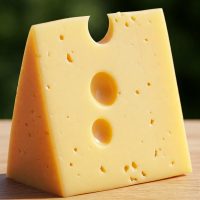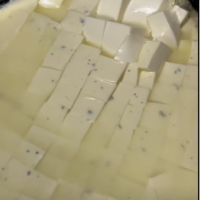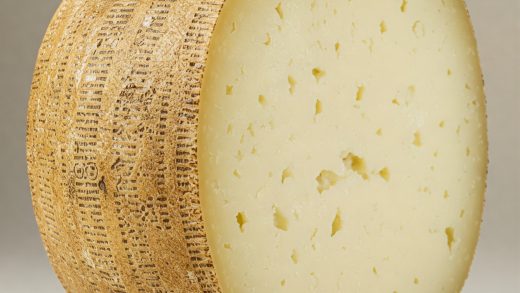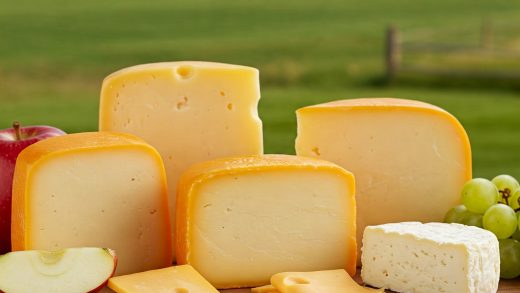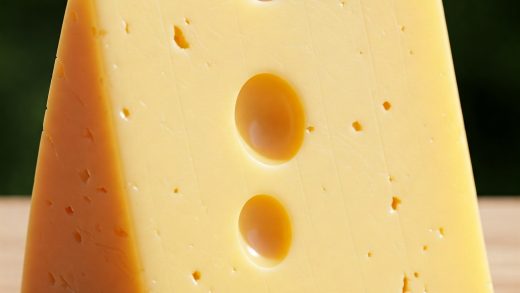The cheese with holes is generally known as Swiss cheese. However, Emmental is the original and most famous Swiss cheese recognized for its holes. You might also hear other cheeses with holes referred to as “Swiss-type” cheeses.
Have you ever looked at a slice of cheese with holes and wondered about them? Maybe you even remember cartoons like Tom and Jerry.
They always seemed to have cheese with those funny craters. That kind of cheese is often called Swiss cheese. You know it by its characteristic “eyes” or holes.
But have you ever thought about why some cheeses get those openings? Well, you’re about to find out! This blog post will explain the cool science and interesting story behind those cheesy holes.
sYou’ll learn the reasons why certain cheeses develop these signature features. We’ll also explore some of the most famous holey cheeses.
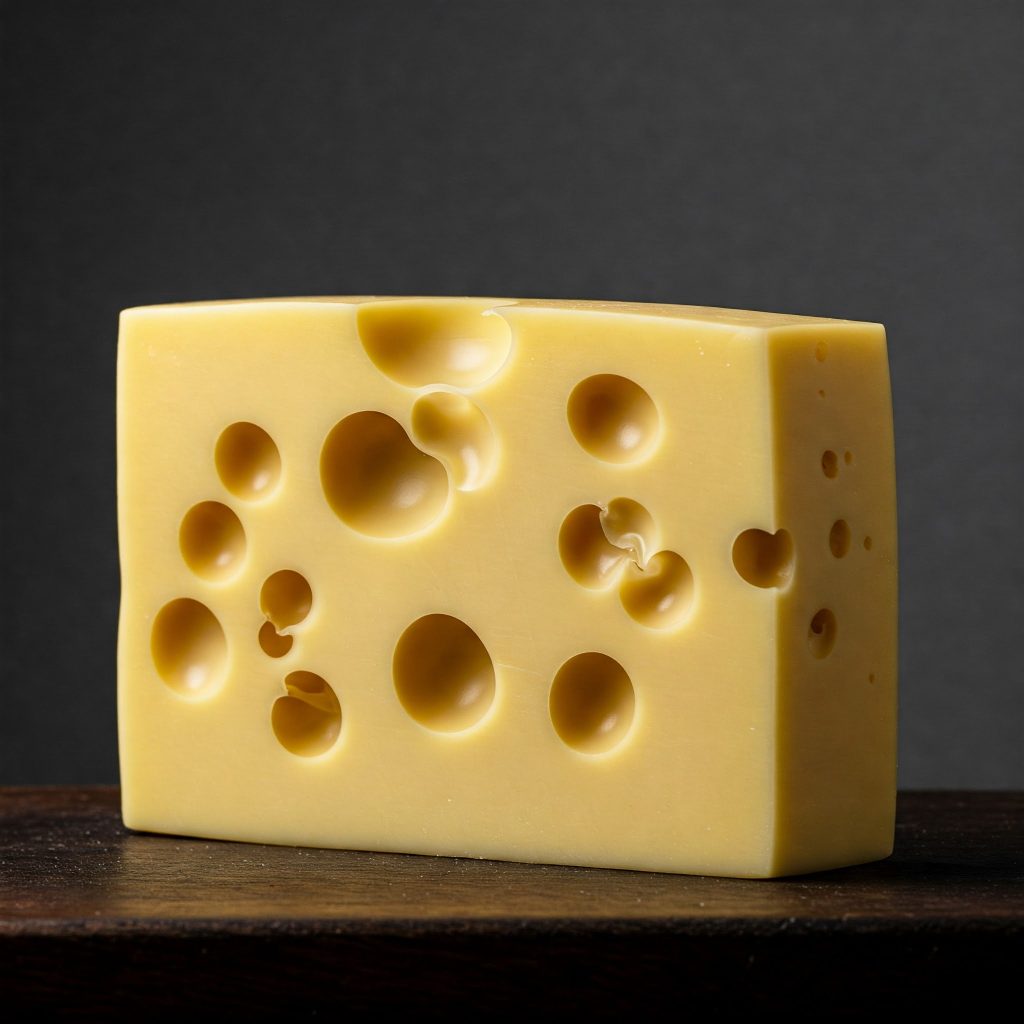
What Exactly is “Swiss Cheese”? (Clarify the terminology)
“Swiss cheese” is a North American term for cheese resembling Emmental. Emmental, originating from Switzerland’s Emmental region, is the iconic “Swiss cheese,” known for its large holes (“eyes”).
However, “Swiss cheese” is a general category. Other “Swiss-type” cheeses, like Gruyère and Appenzeller, also hail from the Alps and may have smaller or fewer holes.Notably, some Swiss cheeses, termed “blind,” are made without any holes.
Therefore, “Swiss cheese” broadly describes a style, with Emmental being the original, and includes both cheeses with and without the characteristic “eyes.”
The Science Behind the Holes (The main explanation)
Ever wondered about those iconic holes in Swiss cheese? It’s a fascinating journey into the world of microbes and milk! Let’s dive into the science behind those “eyes.”
The Historically Accepted Theory: Tiny Workers Creating Bubbles
For a long time, the leading explanation pointed to the amazing work of specific bacteria, primarily Propionibacterium freudenreichii subsp. shermanii. Think of these little guys as busy bees within the cheese:
- They Feast on Lactic Acid: These bacteria love to munch on the lactic acid that’s naturally present in the cheese curd.
- CO2 is Their Byproduct: As they happily consume the lactic acid, they release carbon dioxide (CO2) gas as a byproduct.
- Bubbles Form the Eyes: This CO2 gas, trapped within the semi-solid cheese curd, starts to form tiny bubbles. As the cheese ages and ferments, these bubbles grow larger and rounder, eventually becoming the characteristic “eyes” you see.
The Plot Twist: The Hay Particle Theory
But science is always evolving, and in 2015, a team at Agroscope, a Swiss agricultural institute, offered a new perspective that added another layer to the story. Get this: it might not just be the bacteria!
- Microscopic Weak Points: Their research suggested that microscopic hay particles that sometimes find their way into the milk play a crucial role.
- Nucleation Sites: These tiny hay particles create weak spots within the structure of the cheese curd. These weak points act as perfect gathering spots, or nucleation sites, for the CO2 gas produced by the bacteria.
- Holes Form Around Particles: Instead of the gas randomly forming bubbles, it preferentially collects around these hay particles, leading to the formation of the holes.
Modern Milking and Fewer Holes?
Interestingly, the study also suggested that modern, more hygienic milking techniques, which reduce the amount of hay in milk, could be a reason why some modern Swiss cheeses have fewer or smaller holes. Pretty neat, huh?
What Else Influences Those Holes?
Beyond the bacteria and hay particles, several other factors come into play to determine the size and number of those distinctive holes:
- Temperature During Aging: The temperature at which the cheese is aged significantly impacts the activity of the bacteria and the expansion of the CO2 gas. Warmer temperatures generally lead to more and larger holes.
- Duration of Fermentation: The longer the fermentation period, the more time the bacteria have to produce CO2, potentially resulting in more pronounced “eyes.”
- Different Bacteria Strains: Just like there are different types of apples, there are different strains of bacteria. These strains can have varying levels of activity and gas production, influencing the final look of the cheese.
So, the next time you enjoy a slice of Swiss cheese, remember the fascinating science – the tiny bacteria working tirelessly and perhaps even those minuscule hay particles playing their part in creating those iconic holes!
Beyond the Science: Interesting Facts and Varieties
Beyond the microscope and the gas production, Swiss cheese and its holey cousins have some pretty interesting stories and uses!
More Than Just Looks: Holes as a Flavor Indicator?
Interestingly, the size and number of those characteristic holes were historically thought to be a clue about the cheese’s flavor and how mature it was.
It was often believed that cheeses with larger and more numerous holes had a stronger, more developed flavor.
While modern science has shown the hole formation is more complex than just flavor intensity, this historical association is still a fun fact to chew on!
The Holey Extended Family
Emmental isn’t the only cheese sporting holes! You’ll find “eyes” in other delicious varieties too:
Jarlsberg: This Norwegian cheese is famous for its larger, round, and evenly distributed holes and its mild, nutty flavor.
Some Goudas and Havartis: While not always present or as prominent as in Swiss-types, some Goudas and Havartis can develop smaller or more occasional holes during their aging process. These holes often have a different origin and appearance compared to those in Emmental or Jarlsberg.
In the Kitchen: A Melty Marvel
Swiss cheese, with its generally mild, nutty, and sometimes slightly sweet flavor, is a fantastic addition to many culinary creations, largely due to its excellent melting properties. Think about:
- Grilled Cheese Sandwiches: It melts beautifully and creates that gooey, satisfying pull.
- Fondue: A classic use that highlights its smooth melting texture and flavor.
- Gratins and Casseroles: It adds a lovely richness and melts evenly over dishes.
- Quiches and Omelets: Its mild flavor complements eggs and other ingredients.
- The Visual Appeal: Those Iconic Eyes
Let’s be honest, those holes are part of the visual charm of Swiss cheese! They’ve become an iconic representation in cartoons, illustrations, and even just in our minds when we think of cheese.
There’s something undeniably appealing about those perfectly formed “eyes” that makes Swiss cheese instantly recognizable and often adds a playful touch to a cheese board.
Conclusion
So, the next time you encounter those distinctive “eyes” in Swiss cheese, remember it’s a result of a fascinating dance between tiny Propionibacterium bacteria producing CO2 and potentially microscopic hay particles providing nucleation points.
It’s a testament to the beautiful blend of scientific processes and time-honored cheesemaking traditions. Take a moment to appreciate the bubbly artistry in your next slice! What’s your favorite cheese with holes and why?



